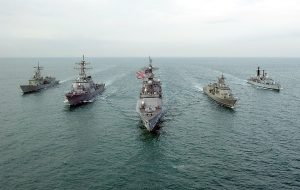
There is a cancer at the heart of the United States Armed Forces, and therefore, Western military thought, a cancer that first appeared in 1970, and slowly wormed its way into the minds within the Pentagon. Those minds, desperately seeking to rationalize the failures of relying on “logic” and statistical analysis to frontline, “real world” combat developed by Robert McNamara and his “Whiz Kids”, swiftly absorbed the writings of an academic “futurist” couple, who had never been faced with the reality of any form of military service.
The toxic influence of Alvin and Heidi Toffler on US military thinking over the past 35 years represents one of the most consequential intellectual failures in modern defense policy. Through their seductive but fundamentally flawed “waves of warfare” theory, the Tofflers provided Pentagon planners with an oversimplified framework that has repeatedly led American forces astray, contributing to strategic disasters from Somalia to Afghanistan.
This has manifested into what Colonel Michael Pietrucha, USAF (Ret.) called the “Death of Military Strategy”, an apt appelation that has – unintentionally – contributed to the skyrocketing suicide rate among both serving members of the military, as well as in the veteran community.
The Tofflers’ central premise, outlined in their 1993 book “War and Anti-War,” posited that warfare evolves through distinct “waves”, corresponding to economic development:
- First Wave: agricultural warfare
- Second Wave: industrial warfare
- Third Wave: information-age warfare
However, critics noted from the beginning that “the Tofflers have suffered some critical reviews of their work, especially concerning their selective historical perspective.”
The Seductive Appeal of Technological Determinism
The Tofflers’ influence coincided with America’s post-Cold War search for military transformation and “the American way of war’s fascination with technology and the search for that technological ‘silver bullet’ that will deliver victory quickly and with a minimum of loss of life.” Their theory, echoing McNamara’s insistence on the superiority of logically and emotionlessly applied statistical analysis and comparison, offered Pentagon leaders exactly what they wanted to hear: that American technological superiority would render traditional military concerns obsolete.
Their ideas became particularly influential among political figures like Newt Gingrich, who called “The Third Wave” one of the “great seminal works of our time,” and among military leaders seeking to justify massive investments in information warfare capabilities. By the early 1980’s, “the Tofflers’ work had begun to influence the thinking of some influential members of the U.S. military. And by the early 1990’s, the transforming U.S. military had begun to influence the thinking of the Tofflers.”
No doubt, this has been a massive boon to the defense industry, who were suddenly handed every excuse necessary to produce all the “latest and greatest” toys, at staggering prices…like the M1301 ISV.
The Fundamental Flaws
Military analysts began identifying serious problems with Tofferian thinking. Academic critiques argued that “the Tofflers’ concepts of First, Second, and Third Wave warfare are overgeneralized and distort historical understandings of Western warfare,” urging “military leaders to reassess these theories and explore the necessity for more nuanced frameworks that better reflect the complexities of modern warfare.”
Critics noted that while the Tofflers’ “approach is fundamentally sound, it fails to address transitional forms of warfare and omits conceptual changes in warfighting introduced by Gustavus Adolphus, Napoleon Bonaparte, and others.” The theory’s rigid categorization ignored the persistent importance of geography, culture, politics, and human factors in warfare.
And those last four factors are just the tip of the iceberg. Any “theory of war” that ignores – or worse, dismisses – those factors is guaranteed to fail, every time…as recent history has amply demonstrated.
Strategic Consequences
The Toffler-influenced Revolution in Military Affairs (RMA) led to several catastrophic strategic miscalculations. The Pentagon’s obsession with “Third Wave” information warfare and precision strikes created a dangerous overconfidence in technology’s ability to solve complex political problems. This thinking directly contributed to:
- The belief that shock and awe tactics in Iraq would create rapid political transformation
- Underestimation of insurgent adaptability in Iraq and Afghanistan
- Over-reliance on surveillance technology while neglecting human intelligence
- The mistaken assumption that information dominance could substitute for adequate troop levels
Military historians noted how “RMA proponents over-emphasize the importance of technology in driving revolutionary change,” arguing that “leadership along with institutional, organizational, and intellectual initiative are equally, if not more, important than technological innovation.”
The Persistence of “First Wave” Realities
The ultimate irony of Toffler influence is how consistently “primitive” opponents have outmaneuvered America’s high-tech military. From Somali militias to Taliban fighters to Iraqi insurgents, adversaries using decidedly “First Wave” tactics – guerrilla warfare, improvised explosives, local knowledge – repeatedly frustrated America’s “Third Wave” military machine.
As one analyst observed, “It is the great equalizer, you don’t have to be big and rich to apply the kind of judo you need in information warfare. That’s why poor countries are going to go for this faster than technologically advanced countries.” The Toffler’s failed to anticipate how their own theories would be turned against American forces.
The bottom line is that in the 60 years from 1965 to 2025, the vast majority of land-based conflicts have been won by guerrilla or insurgent forces, using rudimentary uniforms, organization, weapons, vehicles, tactics, and propaganda strategies that are not far removed from World War 2. These forces – whatever their political or religious leanings – know what they want to accomplish, know their target audiences, and know how to use their available resources to maximum effect.

This is not a function of “disruptive” technologies like mini-drones or the Internet. Those are just democratized tools, all of which have countermeasures that can be quickly developed and deployed, as is now happening across the conflict zones map. Whet the Toffler’s ignored, is that technology disperses, eventually. The damning part of this, is that it was recognized as early as 1940 by professional officers of the United States Marine Corps – something the Toffler’s could have easily found, had they been doing actual “research”:
“…If marines have become accustomed to easy victories over irregulars in the past, they must now prepare themselves for the increased effort which will be necessary to insure victory in the future. The future opponent may be as well armed as they are; he will be able to concentrate a numerical superiority against, isolated detachments at the time and place he chooses; as in the past he will have a thorough knowledge of the trails, the country, and the inhabitants; and he will have the inherent ability to withstand all the natural obstacles, such as climate and disease, to a greater extent than a white man. All these natural advantages, combining primitive cunning and modern armament. will weigh heavily in the balance against the advantage of the marine forces in organization, equipment, intelligence and discipline, if a careless audacity is permitted to warp good judgment…” – FMFRP 12-15 Small Wars Manual (1940)

Lasting Damage
Three and a half decades later, American military culture remains infected by Toffler-style techno-optimism. Despite repeated failures, Pentagon planning still prioritizes platform acquisition over strategic thinking, information dominance over cultural understanding, and technological solutions over political wisdom. The Tofflers provided intellectual cover for avoiding warfare’s fundamental realities, creating a generation of military leaders who confused gadgetry with strategy.
The time has come to recognize the Toffler influence for what it was: a seductive but dangerous distraction that cost American lives, squandered resources, and undermined strategic effectiveness when it mattered most.








